CRYO-S Painless for cryoanalgesia in pectus excavatum, thoracic surgery


Access to the content of metrum.com.pl is available only to medical professionals and representatives of entities performing medical activities or trading in medical devices.
I declare that I am a medical practitioner or medical device trader.
Thank you for visiting our website.
We are sorry, but our website is intended only for persons practicing the medical profession or trading in medical devices in accordance with applicable law.